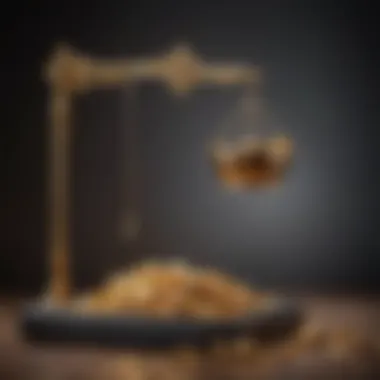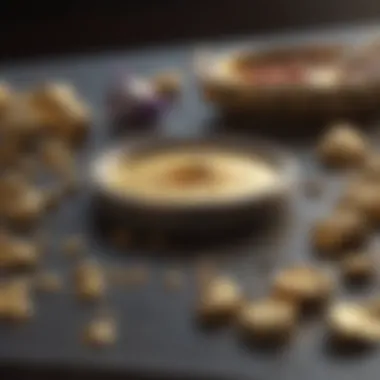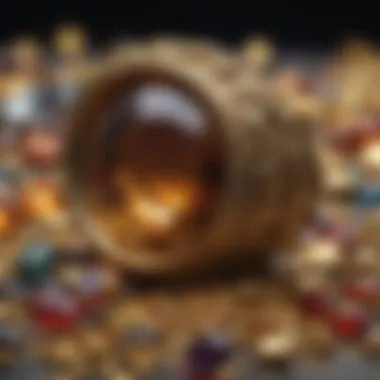Determining the Value of Scrap Gold Jewelry


Intro
The world of scrap gold jewelry often seems like a hidden treasure trove. It holds potential value for those who know where to look and what to consider. As individuals accumulate jewelry items that may no longer carry sentimental value, recognizing their worth can lead to unexpected financial gains. Whether you’re cleaning out old heirlooms or seeking to astutely invest in gold, understanding the nuances that affect scrap gold pricing is essential.
By unveiling various aspects, from the purity of gold to shifting market markers, this article aims to arm readers with knowledge. With that goal in mind, we explore how to navigate the scrap gold market effectively.
Understanding the Worth of Scrap Gold
Before jumping into how to evaluate scrap gold jewelry, it’s prudent to grasp what influences its overall value. Here's a look at some fundamental factors:
- Purity: This typically refers to the gold content in an item, often measured in karats.
- Market Trends: The price of gold fluctuates, influenced by economic factors and global events.
- Condition: A worn piece may fetch less than an intact item, however, some wear can add character.
- Gold Type: There are different kinds of gold, like yellow, white, and rose; each has its market appeal.
As we delve deeper, these ideas will unfold, enabling you to pinpoint what makes your scrap gold truly priceless.
Preface to Scrap Gold Jewelry
Understanding the nuances of scrap gold jewelry is paramount for anyone looking to evaluate its worth. In a world where gold often serves as a symbol of wealth and stability, scrap gold represents not just remnants of jewelry but also potential profit. Whether it’s an old, broken piece lying in a drawer or a collection of inherited items, discovering the true value of scrap gold can lead to significant financial benefits.
Defining Scrap Gold
Scrap gold is essentially gold that is no longer being used in its original form. It can come from damaged jewelry, outdated designs, or even industrial scrap from manufacturing processes. Importantly, not every piece that contains gold carries the same value. When we talk about scrap gold, it is crucial to understand factors like its purity, weight, and the current market price for gold. Each piece holds a story — from wedding bands that ended in divorce to antique brooches that have simply lost their appeal. Recognizing these pieces as "scrap" opens the door to evaluating their worth accurately.
Importance of Evaluating Scrap Gold
The evaluation of scrap gold serves multiple purposes. First and foremost, it guides sellers in determining how much they can expect to receive if they decide to sell their items. Knowing the evaluation process can prevent many individuals from falling into the traps set by unethical buyers who might undervalue their pieces. Furthermore, scrap gold evaluation enhances financial literacy regarding precious metals. Additionally, focusing on scrap gold can lead to surprising revelations about the actual worth of seemingly insignificant items. In essence, weighing the worth of scrap gold jewelry is not just a means to an end; it's an essential skill in understanding value in the broader context of financial management and investment.
Understanding Gold Purity
The term karat is widely recognized in the jewelry market and is used to define the purity of gold. Higher karat numbers indicate a greater proportion of gold compared to other metallic substances, which directly influences market value. For instance, a piece that is 24 karat gold is pure gold, whereas something with 14 karats contains approximately 58.3% gold, meaning the rest is made up of varying alloys. Each piece of scrap gold may contain different karats based on its origin and wear, which is why understanding these differences is crucial.
There are several benefits to understanding gold purity:
- Accurate Valuation: When you gauge the purity of your gold, you can compute its true worth with more precision.
- Market Insight: Understanding the different types of gold alloys can lead to better decisions while navigating the sell and purchase landscape.
- Informed Selling: Knowledge of purity can empower you in negotiations with potential buyers or appraisers.
Considering the importance of this knowledge, let's explore the specifics of measuring gold purity and its implications.
The Scrap Gold Market
Understanding the scrap gold market is vital for anyone looking to assess the value of their gold jewelry. Whether you're cleaning out your old pieces or looking to make some money, the market dynamics can significantly influence your returns. Knowing how the market operates not only helps in determining when to sell but also aids in making informed decisions regarding the evaluation of your scrap gold.
The fluctuations in gold prices can be both a boon and a bane for sellers. Prices can swing quite dramatically based on various international factors including currency values, political climate, and mining outputs. For instance, a spike in demand from industries or investors can lead to higher gold prices, while an oversupply can drag them down. It's like catching a wave; timing is everything!
Current Market Trends for Gold


As of recent trends, the gold market has been gaining traction. Investors often flock to gold during economic uncertainties, viewing it as a safe-haven asset. In recent months, the price of gold has seen a steady rise due to factors like inflation and geopolitical tensions. Everyone and their grandma seem to be eyeing gold as a protective measure against financial instabilities. The world has witnessed repeated instances where gold prices have surged, especially during times of uncertainty.
- Global Demand: Countries like China and India are consistently leading in gold consumption, fueling a robust market. The inclination of consumers to invest in gold jewelry is not merely a cultural trait; it's become a fundamental pillar of investment philosophy.
- Investment Sentiment: Many people are now treating gold like a stock, keeping a keen eye on market movements. Investors are not just casual participants; they're strategists looking to maximize their gains.
- Market Sentiment Indicators: Various indices that track gold-related investments provide insights into the market's direction. Watching these trends reveals potential moments for buyers and sellers to act.
"In the world of scrap gold, understanding current trends allows you to maximize your profits and minimize losses."
Historical Price Trends of Gold
Peeking back into the historical data of gold prices reveals a fascinating journey. Over decades, gold has shown patterns that are often cyclical. Looking at these historical price trends gives context to today's market dynamics.
From the late 20th century to today, gold's price trajectory has been anything but static. During the 1980s, for instance, we saw a significant peak that was followed by a painful decline. However, the 2000s were a transformative decade for gold, with prices far exceeding previous highs as economies faltered and uncertainty loomed.
Here are a few pivotal moments in gold's price history:
- 2008 Financial Crisis: Gold prices sharply rose as investments in traditional markets dried up.
- Post-2011 Surge: After hitting an all-time high in 2012, gold prices began to adjust, showing the market’s ability to recover.
- Recent Years: Price shifts have leveled out, influenced by a complex interplay of economic recovery post-pandemic, inflation jitters, and shifts in central bank policies.
Studying these trends offers insights into potential future movements. It’s essential to remember that past performance does not predict future results, but it does equip sellers with a context that might point toward potential market turns.
Evaluating Scrap Gold Jewelry
Evaluating scrap gold jewelry is not just a routine step in the selling process but a critical engagement that can significantly bolster your returns. In an era where the gold market can be as volatile as an unsteady ship in a storm, knowing how to gauge the worth of your items allows you to navigate this treacherous terrain effectively. This section serves as a road map, exposing the various facets of gold evaluation that can make or break a deal.
Step-by-Step Evaluation Process
A structured approach works wonders when dealing with scrap gold. It's about digging deep into those details that matter and ensuring that nothing falls through the cracks. Let's break it down into actionable steps.
Assessing Weight and Purity
When entering the gold evaluation process, weighing your scrap is akin to laying the foundation for a sturdy building. It establishes a starting point. Weight, measured in grams, is straightforward enough, but the purity aspect—expressed in karats—plays a pivotal role. Higher purity means your gold holds more value. For instance, a 24k gold piece is worth significantly more than a 10k piece when it hits the market.
One key characteristic here is that assessing weight and purity can often be done using basic tools found at home, like a kitchen scale for weight and an acid test kit for purity. This accessibility makes it a popular choice among sellers who may, understandably, be hesitant to part with their belongings without a deep understanding of their value.
However, there are pitfalls in this DIY approach. The accuracy of your tools can vary, and the skills needed to interpret the purity tests require a bit of practice. An inaccurate reading might lead you to undervalue your pieces, ultimately causing you to leave cash on the table.
Calculating the Value Per Gram
Once you’ve assessed weight and purity, it’s time to roll up your sleeves and calculate the value per gram of your gold. Current market prices dictate this figure, which fluctuates regularly. By knowing the price of gold per gram, you can multiply this by the weight of your scrap and adjust for its purity.
The beauty here lies in transparency; you can substantiate your valuation with market data, proving that what you're asking for isn't merely pulled from thin air. But remember, market price isn’t the only story. Knowing how to leverage your gold's unique characteristics doesn’t hurt if the gold features intricate designs or historical significance.
Still, the calculation does have its downsides. Market prices can vary among buyers, and some may not offer the highest price based on their internal costs. It's essential to do thorough research ahead of selling to ensure you strike a deal that brings you satisfaction.
Professional Appraisal vs. DIY Evaluation


The debate of professional appraisal versus a do-it-yourself approach is an age-old conundrum among gold sellers. Professional appraisals carry authority; experts bring years of experience and can identify nuances that may escape the average eye. This form of assessment can provide a certified valuation, which can be invaluable when selling.
On the flip side, not everyone is keen on shelling out hard cash for an expert opinion. DIY evaluation methods offer a sense of empowerment that appeals to many. Learning to assess weight, purity, and market value lets sellers take control of their gold's fate.
However, weigh the options carefully—professionals can provide an accurate picture that might be well worth the upfront cost, especially if you possess particularly valuable pieces. Conversely, DIY evaluations may be suitable for everyday items where the overall value isn't as impressive. Regardless of the route chosen, understanding the merits and drawbacks of each is critical to making an informed decision.
"An educated seller is an empowered seller."
In summary, the importance of evaluating scrap gold jewelry cannot be overstated; it lays the groundwork for making informed decisions and maximizing value.
Selling Scrap Gold Jewelry
Selling scrap gold jewelry is a key step in unlocking the value of unwanted or broken items. The process not only allows individuals to declutter but also provides an opportunity to convert unused jewelry into cash. It's essential to understand the best places to sell and how to navigate potential pitfalls to ensure a fair transaction.
Where to Sell Scrap Gold
When it comes to selling scrap gold, knowing your options can make all the difference. Each avenue offers distinct advantages and disadvantages, catering to different preferences and situations.
Local Jewelers
Selling to local jewelers can be a smart move, particularly for those who value face-to-face interaction. These shops often have knowledgeable staff who can provide insights into your gold's worth.
One key characteristic of local jewelers is their tendency to offer immediate payment, allowing you to walk away with cash in hand. They often deal in high-quality items and might be more inclined to give you a fair price based on their expertise and market understanding. A unique feature of local jewelers is that they might buy not just the gold but also assess the craftsmanship of the piece, which can add to its overall value.
However, a disadvantage may be found in limited offers. Local jewelers may have less flexibility in pricing compared to larger buyers or online options, as their operational overhead can restrict the premium they can pay for the gold.
Online Marketplaces
Online marketplaces have emerged as a popular avenue for selling scrap gold, offering a broader reach and potentially higher prices. Websites specializing in precious metals allow sellers to connect directly with buyers, creating competition that can drive up prices.
A notable advantage of using these platforms is the extensive variety of vendors. From small businesses to large recycling firms, you're likely to find multiple options competing for your gold. Online marketplaces also provide the convenience of selling from home, eliminating the need for travel or in-person negotiation.
But there are drawbacks. The process can require patience, as listings may take longer to sell compared to a quick sale at a local jeweler. Additionally, sellers might face shipping fees and complications regarding the authenticity of the buyer, leading to potential scams in some cases.
Pawn Shops
Pawn shops are often seen as a quick and easy way to sell scrap gold jewelry. One defining aspect of pawn shops is their willingness to quickly assess jewelry and make an instant offer. This characteristic can appeal to those who need immediate cash or prefer a straightforward process.
The unique feature of pawn shops is that they lend against the value of the gold, allowing sellers to reclaim their items if they later have the means to do so. This can provide a safety net for those unsure about permanently parting with their gold.
Yet, it's worth noting that pawn shops are typically known for lower prices compared to other selling avenues. The convenience comes with potentially receiving less than you might on the open market, as their business model is often tied to quick transactions rather than maximizing seller returns.
Understanding Fees and Commissions


When selling scrap gold, it's crucial to be aware of the various fees and commissions that can impact your final earnings. Different venues will have distinct fee structures that can eat into profits. For instance:
- Local jewelers may not charge explicit fees but may offer lower prices due to their overhead costs.
- Online marketplaces might have listing fees or commissions off the final sale price, which could reduce your expected payment.
- Pawn shops often factor in their margin or offer less upfront, which is a form of a commission.
Understanding these elements is key to maximizing your returns. Knowing where to sell and being aware of related costs will empower you to make the most informed decisions possible.
Avoiding Common Pitfalls
Recognizing Scams in the Scrap Gold Market
In a marketplace as dynamic and sometimes chaotic as the scrap gold industry, scams can pop up like weeds in a garden. Recognizing these scams is a matter of being vigilant and informed.
One common tactic scammers employ is offering drastically higher prices than the market rate. If someone claims they’ll pay you an exorbitant amount for your gold, take a step back. This is often a red flag pointing towards a scheme designed to either underpay or push you into a complicated transaction. Do your research; check current market prices through reliable sources like en.wikipedia.org or financial news outlets before finalizing any deals.
Another area to watch out for is misleading valuations. Some local jewelers or pawn shops may claim your jewelry has a higher purity than it does. A simple yet effective way to sidestep this issue involves requesting an independent appraisal. An impartial expert can provide a clear picture of the actual value based on gold content, karat weight, and current market values.
Don’t let the shifty promises of individuals who operate in the shadows lead you astray. When in doubt, consult knowledgeable communities on platforms like reddit.com or engage in conversations with fellow enthusiasts to compare notes and verify practices. The more information you gather, the better equipped you'll be to identify potential scams.
Debunking Myths Surrounding Scrap Gold Values
The world of scrap gold is rife with myths that can really cloud one’s judgment and understanding. First and foremost, there's the common belief that "all scrap gold is created equal". This notion couldn’t be further from the truth. The worth of scrap gold hinges not just on the weight but significantly on the purity of the gold, which can vary substantially from piece to piece.
Another widespread myth is that the condition of the jewelry has no bearing on its value. This is incorrect. While the purity of gold remains the ultimate judge of its worth, the design, craftsmanship, and the piece's historical significance can add considerable value as well. For instance, antique or designer pieces might fetch a higher price even if they are not solid gold.
Many people also think that online prices are significantly lower than physical shops. In reality, online platforms can offer competitive rates, and sometimes even better. Selling through trusted online marketplaces can eliminate the need for middlemen, allowing you to retain a larger chunk of the profits.
Always be wary of these myths as they can lead to underestimating the true value of your scrap gold. Knowledge is power; equip yourself with the right insights, and you will find navigating the scrap gold market less akin to wandering through a maze and more like following a well-marked trail.
"An informed seller is often a successful seller."
Being mindful of these common pitfalls not only protects your resources but also empowers you as you enter the bustling world of scrap gold jewelry evaluation.
Ending
The worth of scrap gold jewelry is not merely a straightforward number; it’s a reflection of various factors intertwined with market dynamics, intrinsic values, and personal decisions. Understanding these elements is pivotal for anyone looking to sell or appraise their gold jewelry.
Weighing the Decision to Sell Scrap Gold
Before taking the plunge into selling scrap gold, it's vital to take a step back and ponder a moment about your own pieces. Ask yourself: are these items purely sentimentality, or do they carry a tangible value? You might hold onto what was once a treasured gift or an heirloom. Yet, regardless of its past, the decision to part with it should involve thorough consideration of current market prices, gold purity, and individual sentiment.
To help in making this choice:
- Reflect on previous valuations. Has the market shifted?
- Is there a consistent emotional connection with the item? Would you regret selling it later?
- Consider potential financial needs. Would the money from the sale significantly aid your circumstances?
Taking the time to weigh these factors allows oneself to come to a decision rooted in both logic and emotion.
Future Considerations for Gold Valuation
The landscape of gold valuation is ever-evolving. Changes in geopolitical climates, shifts in global economies, and even technological advances can alter gold’s perceived worth. Therefore, keeping an eye on the broader picture is essential for anyone interested in scrap gold. It's also wise to monitor:
- Market Shifts: Pay attention to fluctuating gold prices. Historical trends may provide insight into future movements.
- Inflationary Effects: Gold often acts as a hedge against economic instability. As inflation rises, gold prices could also soar, impacting valuation.
- Purity Standards: Innovations in alloy compositions may lead to evolving standards. Knowing what affects your gold's purity can influence its re-sale value.



